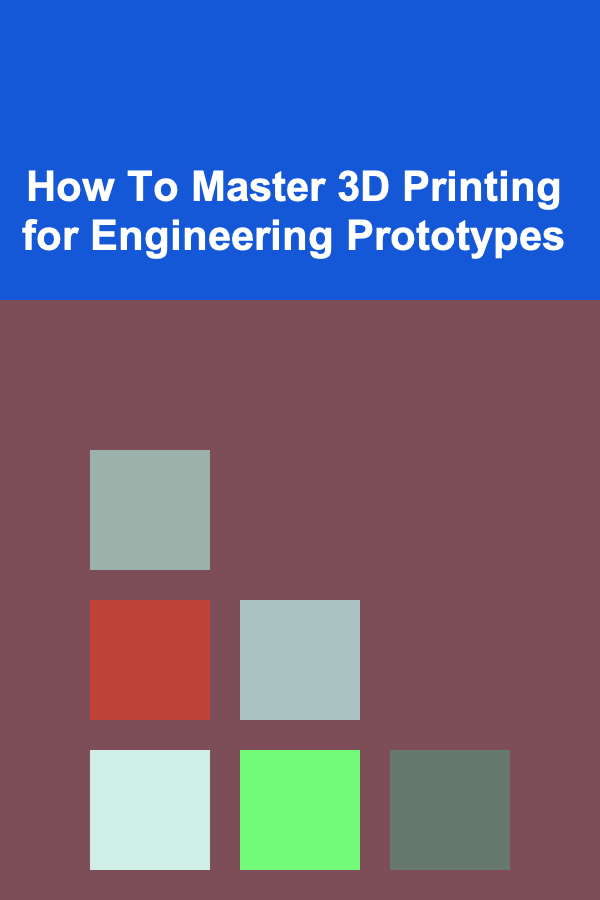
How To Master 3D Printing for Engineering Prototypes
ebook include PDF & Audio bundle (Micro Guide)
$12.99$10.99
Limited Time Offer! Order within the next:

In recent years, 3D printing has revolutionized the field of engineering by offering an innovative and cost-effective way to create prototypes, functional parts, and complex components. While 3D printing has been around for decades, its rapid evolution has significantly impacted the way engineers approach product development, design iterations, and testing. Mastering 3D printing for engineering prototypes is an essential skill for engineers, designers, and innovators who want to stay ahead of the curve. This guide provides a deep dive into the process, technologies, applications, and best practices to master 3D printing for engineering prototypes.
Understanding 3D Printing Technology
Before diving into how to effectively use 3D printing for engineering prototypes, it's essential to understand the technology behind it. 3D printing, also known as additive manufacturing, is a process where three-dimensional objects are created by adding material layer by layer based on digital models. Unlike traditional manufacturing methods, such as subtractive machining or injection molding, which remove material from a solid block, 3D printing builds up the object from the ground up.
Types of 3D Printing Technologies
There are several different types of 3D printing technologies, each with its own unique advantages and limitations. The most commonly used technologies for engineering prototypes include:
1. Fused Deposition Modeling (FDM)
FDM is one of the most widely used 3D printing technologies. It works by extruding thermoplastic material through a heated nozzle, which deposits the material layer by layer to create the desired object. FDM is known for being cost-effective and suitable for producing functional prototypes and concept models. However, it typically lacks the level of detail found in other technologies.
2. Stereolithography (SLA)
SLA uses ultraviolet (UV) light to cure liquid resin in a layer-by-layer fashion to create solid objects. It produces highly detailed and smooth prototypes, making it ideal for applications requiring precision, such as small components or intricate designs. SLA is often used for engineering prototypes that require fine features, but the process can be slower than FDM.
3. Selective Laser Sintering (SLS)
SLS uses a laser to sinter powdered material, usually plastic, metal, or ceramic, and fuses the particles together layer by layer. Unlike FDM and SLA, SLS can produce prototypes that do not require support structures, making it ideal for complex geometries. SLS is commonly used for producing end-use parts, as well as durable and functional prototypes.
4. PolyJet Printing
PolyJet technology works by spraying liquid photopolymer droplets onto the build platform and curing them with UV light. This method allows for high precision, multi-material printing, and a wide range of material properties, making it suitable for prototypes that need to replicate the final product's material characteristics. PolyJet is particularly useful for creating complex assemblies or multi-material parts.
Materials Used in 3D Printing
One of the key aspects of mastering 3D printing for engineering prototypes is understanding the materials that can be used in the process. The choice of material has a significant impact on the strength, flexibility, durability, and overall functionality of the prototype. Some of the most common materials include:
- Thermoplastics: Materials like ABS, PLA, and nylon are commonly used in FDM printing. They offer varying levels of strength and flexibility and are widely used for producing functional prototypes.
- Resins: SLA and PolyJet printers commonly use resin materials, which can vary in their properties, including rigidity, transparency, and flexibility.
- Metals: SLS and other metal 3D printing technologies use powdered metals such as stainless steel, titanium, and aluminum to produce high-strength, durable prototypes.
- Composites: Some 3D printers can work with composite materials, which combine the properties of two or more materials, such as carbon fiber-reinforced filaments. These materials provide added strength and rigidity.
Design for 3D Printing
Designing for 3D printing is an essential skill that can significantly improve the success rate and quality of engineering prototypes. 3D printing has unique constraints and possibilities that differ from traditional manufacturing methods. Here are some key principles to keep in mind when designing for 3D printing:
1. Understand the limitations
Every 3D printing technology has its own set of limitations. For example, FDM printers may struggle with overhangs or intricate details, while SLA printers might have build size constraints. It's important to design with these limitations in mind to ensure that the final prototype can be successfully printed.
2. Consider orientation and support structures
The orientation of the object on the build platform plays a crucial role in the strength and quality of the print. Some geometries may require support structures to prevent sagging or warping during printing. Engineers need to plan for the orientation and whether support structures will be necessary. The removal of these supports can sometimes leave marks or affect the final finish, so minimizing the need for supports is ideal.
3. Design with tolerance and fit in mind
Although 3D printing has made significant strides in precision, it's important to consider tolerances when designing parts that need to fit together. Tolerances in 3D printed parts can vary depending on the printing technology and material used, so designing parts with slight allowances for variation is crucial, especially for assemblies or moving parts.
4. Iterative design
One of the greatest advantages of 3D printing is the ability to quickly iterate on designs. Engineers should take advantage of the rapid prototyping nature of 3D printing by producing multiple iterations to test and refine designs. This iterative process helps engineers identify issues early in the development process, saving time and money.
Best Practices for Mastering 3D Printing for Engineering Prototypes
Mastering 3D printing for engineering prototypes requires a combination of technical skills, design knowledge, and practical experience. Below are several best practices that can help engineers get the most out of their 3D printing efforts.
1. Optimize Your Workflow
Efficiency is key when it comes to 3D printing engineering prototypes. Developing an optimized workflow ensures that time and resources are used effectively. This involves:
- Choosing the right 3D printer and material: Understand the capabilities of different printers and select the one best suited for the prototype's needs, considering factors like material strength, print speed, and resolution.
- Pre-printing preparation: Before printing, ensure that the model is properly oriented, supports are generated where needed, and the correct slicing parameters are set.
- Post-processing: After printing, some prototypes may require cleaning, curing, or finishing to improve their quality and functionality. Familiarize yourself with these post-processing steps to ensure that prototypes are fully functional.
2. Test and Validate Prototypes
3D printing allows for rapid testing and validation of prototypes, which is one of its most powerful advantages. Engineers should not only use prototypes for visual confirmation but also for functional testing. For instance:
- Fit and assembly: Test how well parts fit together and whether there are any issues with tolerances or clearances.
- Functional testing: For prototypes designed to be functional, such as gears or brackets, engineers should perform mechanical or thermal testing to ensure the parts will perform as intended.
- Material testing: Evaluate the material's strength, flexibility, and durability to ensure it meets the functional requirements of the final product.
3. Invest in Training and Education
While 3D printing is relatively easy to get started with, mastering it for engineering prototypes requires specialized knowledge and experience. Engineers should invest in continuous learning and training to stay updated on new materials, techniques, and technologies. This can involve:
- Attending workshops and training courses: Many 3D printing service providers and educational institutions offer training programs specifically for engineers looking to master additive manufacturing.
- Staying updated with industry trends: 3D printing technology is evolving rapidly, and new advancements are constantly being made. Engineers should stay informed about the latest trends, materials, and techniques in 3D printing.
4. Collaborate with Experts
Collaboration with 3D printing experts, whether they are service providers, materials specialists, or software developers, can significantly improve the quality of your prototypes. These experts can offer valuable insights into optimizing designs, selecting materials, and troubleshooting issues that arise during the printing process.
5. Invest in Quality Control
Maintaining consistent quality in 3D printing is crucial, especially when creating prototypes that will be used for further development or testing. Implement a rigorous quality control process to ensure that each print meets the required standards. This includes:
- Monitoring printer calibration: Ensure that the printer is properly calibrated to avoid issues such as misalignment, warping, or inconsistent layer bonding.
- Inspecting prototypes: Visually inspect prototypes for defects such as warping, layer misalignment, or rough surfaces that could affect performance.
Conclusion
Mastering 3D printing for engineering prototypes requires a combination of technical expertise, hands-on experience, and an understanding of design principles. With the right tools, knowledge, and approach, engineers can leverage 3D printing to accelerate the prototyping process, reduce costs, and improve product quality. By carefully selecting the right materials, designing with 3D printing in mind, and following best practices, engineers can create functional, high-quality prototypes that drive innovation and success in their respective fields.

How to Create a Diversified Investment Portfolio Using ETFs
Read More
How to Maintain Consistency in File Organization
Read More
How to Manage Your Finances During a Job Transition
Read More
How to Cook Healthy Soups and Salads for Weight Loss
Read More
How to Interpret Mass Spectrometry Data Like a Pro
Read More
10 Tips for a Luxurious Picnic Experience
Read MoreOther Products

How to Create a Diversified Investment Portfolio Using ETFs
Read More
How to Maintain Consistency in File Organization
Read More
How to Manage Your Finances During a Job Transition
Read More
How to Cook Healthy Soups and Salads for Weight Loss
Read More
How to Interpret Mass Spectrometry Data Like a Pro
Read More